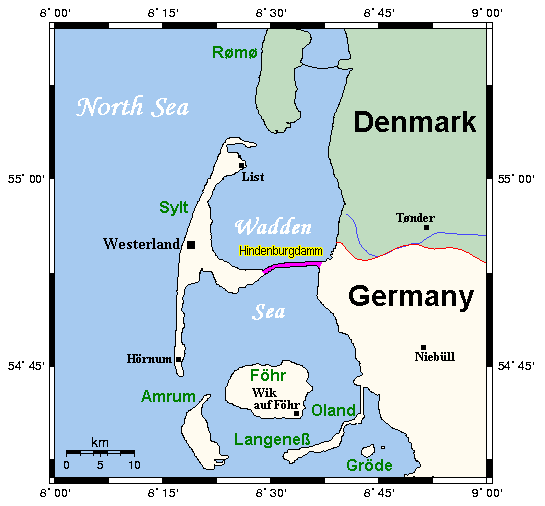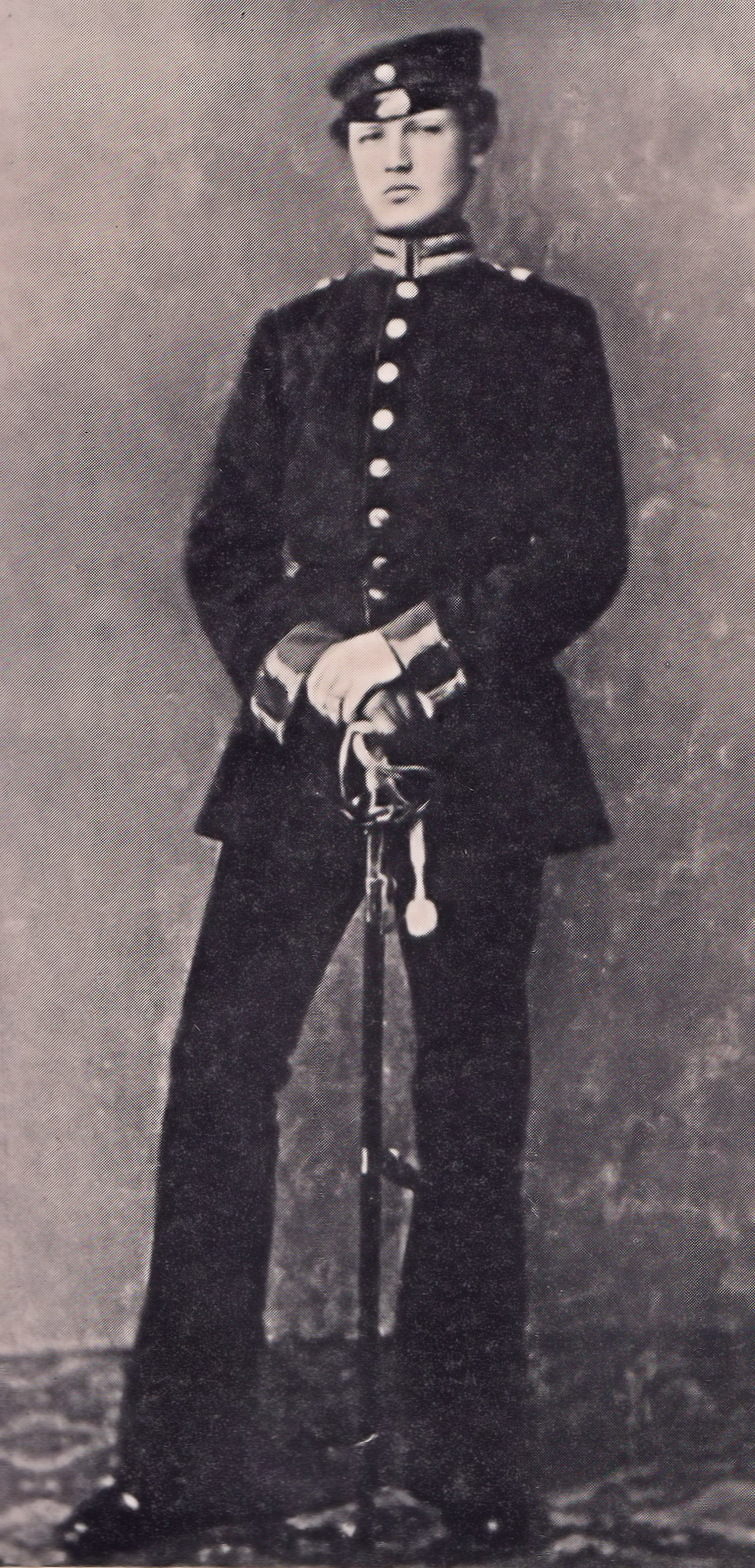 |
Hindenburgdamm
The Hindenburgdamm or Hindenburg Dam is an 11 km-long causeway joining the North Frisian island of Sylt to mainland Schleswig-Holstein. Its coordinates are . It was opened on 1 June 1927 and is exclusively a railway corridor. The companies that built the Hindenburgdamm, a job that took four years, were Philipp Holzmann AG of Frankfurt, working from the mainland, and Peter Fix Söhne of Duisburg working from Sylt. A train trip along the causeway takes about 10 minutes, and the time between the auto terminals at Niebüll on the mainland and Westerland on Sylt is about 30 minutes. The Hindenburgdamm is part of the railway line known as the ''Marschbahn'' ("Marsh Railway"), which is double-tracked along much of the route, although there as yet exists a single-tracked stretch. On the causeway is a signal box. The rail line is not electrified making the use of diesel locomotives necessary. Trains coming from origins further south like Hamburg change from an electric locomotiv ... [...More Info...] [...Related Items...] OR: [Wikipedia] [Google] [Baidu] |
 |
Causeway
A causeway is a track, road or railway on the upper point of an embankment across "a low, or wet place, or piece of water". It can be constructed of earth, masonry, wood, or concrete. One of the earliest known wooden causeways is the Sweet Track in the Somerset Levels, England, which dates from the Neolithic age. Timber causeways may also be described as both boardwalks and bridges. Etymology When first used, the word ''causeway'' appeared in a form such as "causey way" making clear its derivation from the earlier form "causey". This word seems to have come from the same source by two different routes. It derives ultimately, from the Latin for heel, ''calx'', and most likely comes from the trampling technique to consolidate earthworks. Originally, the construction of a causeway utilised earth that had been trodden upon to compact and harden it as much as possible, one layer at a time, often by enslaved bodies or flocks of sheep. Today, this work is done by machines. ... [...More Info...] [...Related Items...] OR: [Wikipedia] [Google] [Baidu] |
 |
Sylt
Sylt (; da, Sild; Söl'ring North Frisian: ) is an island in northern Germany, part of Nordfriesland district, Schleswig-Holstein, and well known for the distinctive shape of its shoreline. It belongs to the North Frisian Islands and is the largest island in North Frisia. The northernmost island of Germany, it is known for its tourist resorts, notably Westerland, Kampen and Wenningstedt-Braderup, as well as for its sandy beach. It is frequently covered by the media in connection with its exposed situation in the North Sea and its ongoing loss of land during storm tides. Since 1927, Sylt has been connected to the mainland by the Hindenburgdamm causeway. In later years, it has been a resort for the German jet set and tourists in search of occasional celebrity sightings. Geography With , Sylt is the fourth-largest German island and the largest German island in the North Sea. Sylt is located from off the mainland, to which it is connected by the Hindenburgdamm. Southeast ... [...More Info...] [...Related Items...] OR: [Wikipedia] [Google] [Baidu] |
|
Marsh Railway
The Marsh Railway (german: Marschbahn) is a main line in the state of Schleswig-Holstein in Germany that links the stations of Elmshorn in the south and Westerland on the island of Sylt in the north. It is part of long route from Hamburg-Altona to Westerland (Sylt) and is listed in the Deutsche Bahn timetables as . The first part of it was opened in 1845 and is one of the oldest lines in Germany. Route The Marsh Railway, as its name suggests, mainly runs through marshlands. There are also some sections of the line that run through the higher-lying geest. The line branches off the Hamburg-Altona-Kiel railway line in Elmshorn. From Elmshorn, it runs in an arc via Glückstadt to Itzehoe. The line then crosses the Kiel Canal on the high Hochdonn High Bridge. The bridge's total length is and its main span over the channel is long. There is also a bascule bridge north of Husum station. Between Klanxbüll and Morsum stations the line runs across the Hindenburgdamm (causeway) ... [...More Info...] [...Related Items...] OR: [Wikipedia] [Google] [Baidu] |
|
 |
Westerland (Schleswig)
Westerland (; da, Vesterland; ''Söl'ring'' North Frisian: ''Weesterlön’'') is a seaside resort and a former municipality located on the German North Sea island of Sylt. Since 1 January 2009, Westerland has been part of the municipality '' Gemeinde Sylt''. Westerland is part of the Nordfriesland district in Schleswig-Holstein. It is the largest resort on the island, the local transportation hub and the centre of Sylt's tourist industry. History Westerland is partly one of the younger settlements on the island of Sylt. After the All Saints' Day Flood of 1436 had destroyed the biggest part of the community of Eidum (except for the area that is today called ''Enden and the Church''), the survivors built a new community to the northeast on a heath. The new settlement was called ''Hedigen'' (heath area). In the 16th. century most of the people on Sylt were involved in the hunting of Herring near Heligoland, Westerland was no exception. The Old Church of Eidum St. Niels was demo ... [...More Info...] [...Related Items...] OR: [Wikipedia] [Google] [Baidu] |
 |
North Frisian Islands
The North Frisian Islands (''Öömrang'' and '' Fering'' frr, Nuurdfresk Eilunen, ''Söl'ring'' frr, Nuurđfriisk Ailönen, link=no, da, Nordfrisiske Øer, german: Nordfriesische Inseln) are the Frisian Islands off the coast of North Frisia. The term covers both the North Frisian Islands in the narrow sense (in Schleswig-Holstein, Germany) and the Danish Wadden Sea Islands (in Denmark). However, culturally and linguistically, the Danish islands are usually not reckoned as being part of North Frisia, since they are not inhabited by native speakers of the North Frisian language. Occasionally, the remote island of Heligoland is also included in this group for reasons of administrative convenience, despite not being located in the Wadden Sea, since the island is home to its own unique dialect of Frisian. History After the Frisian and Danish colonisation of the islands in the 8th century, the Frisian-populated hundreds (between Eiderstedt and Sylt) became the Uthlande. The Nort ... [...More Info...] [...Related Items...] OR: [Wikipedia] [Google] [Baidu] |
 |
Paul Von Hindenburg
Paul Ludwig Hans Anton von Beneckendorff und von Hindenburg (; abbreviated ; 2 October 1847 – 2 August 1934) was a German field marshal and statesman who led the Imperial German Army during World War I and later became President of Germany from 1925 until his death in 1934. During his presidency, he played a key role in the Nazi seizure of power in January 1933 when, under pressure from advisers, he appointed Adolf Hitler as Chancellor of Germany. Hindenburg was born to a family of minor Prussian nobility in Posen. Upon completing his education as a cadet, he enlisted in the Third Regiment of Foot Guards as a second lieutenant. He then saw combat during the Austro-Prussian and Franco-Prussian wars. In 1873, he was admitted to the prestigious '' Kriegsakademie'' in Berlin, where he studied for three years before being appointed to the Army's General Staff Corps. Later in 1885, he was promoted to the rank of major and became a member of the Great General Staff. Following a fi ... [...More Info...] [...Related Items...] OR: [Wikipedia] [Google] [Baidu] |
|
Wadden Sea National Parks
The Wadden Sea National Parks in Denmark, Germany and the Netherlands are located along the German Bight of the North Sea. In Germany and Denmark they also mark the area of the UNESCO World Heritage Site of the Wadden Sea. Divided from each other by administrative borders, they form a single ecological entity. The purpose of the national parks is the protection of the Wadden Sea ecoregion. Denmark * Wadden Sea National Park (Nationalpark Vadehavet), from Blåvandshuk to Rudbøl in Denmark Germany * Schleswig-Holstein Wadden Sea National Park, comprising the west coast of Schleswig-Holstein and the North Frisian Islands * Hamburg Wadden Sea National Park, extending from the mouth of the Elbe to the tiny islands of Neuwerk and Scharhörn, part of Hamburg * Lower Saxony Wadden Sea National Park, comprising the northern coast of Lower Saxony and including the East Frisian Islands Netherlands * Lauwersmeer National Park consists of the southern and eastern parts of the Lau ... [...More Info...] [...Related Items...] OR: [Wikipedia] [Google] [Baidu] |
|
 |
Mudflat Hiking
Mudflat hiking ( da, Vadehavsvandring, nl, Wadlopen, West Frisian: ''Waadrinnen'', german: Wattwandern) is a recreation enjoyed in the Netherlands, northwest Germany, Denmark, England and France. Mudflat hikers are people who, with the aid of a tide table, use a period of low water to walk and wade on the watershed of the mudflats, especially from the Frisian mainland coast to the Frisian islands. The Wadden Sea, a belt of the North Sea, is well suited to this traditional practice. Belts of this shallow sea lie off the mainland of the Netherlands, between Friesland and the Frisian Islands; off the coast of northwestern Germany; and off the coast of southwest Jutland in Denmark. In the Netherlands, mudflat hikers can walk from the mainland to Terschelling, Ameland, Engelsmanplaat, Schiermonnikoog, Simonszand, and Rottumeroog. Other mudflat hiking routes are known but are not recommended, either because of their inherent dangers (the correct path is difficult to follow and/or ... [...More Info...] [...Related Items...] OR: [Wikipedia] [Google] [Baidu] |
|
Tidal Flats
Mudflats or mud flats, also known as tidal flats or, in Ireland, slob or slobs, are coastal wetlands that form in intertidal areas where sediments have been deposited by tides or rivers. A global analysis published in 2019 suggested that tidal flat ecosystems are as extensive globally as mangroves, covering at least of the Earth's surface. / They are found in sheltered areas such as bays, bayous, lagoons, and estuaries; they are also seen in freshwater lakes and salty lakes (or inland seas) alike, wherein many rivers and creeks end. Mudflats may be viewed geologically as exposed layers of bay mud, resulting from deposition of estuarine silts, clays and aquatic animal detritus. Most of the sediment within a mudflat is within the intertidal zone, and thus the flat is submerged and exposed approximately twice daily. A recent global remote sensing analysis estimated that approximately 50% of the global extent of tidal flats occurs within eight countries (Indonesia, China, ... [...More Info...] [...Related Items...] OR: [Wikipedia] [Google] [Baidu] |
|
 |
Schleswig
The Duchy of Schleswig ( da, Hertugdømmet Slesvig; german: Herzogtum Schleswig; nds, Hartogdom Sleswig; frr, Härtochduum Slaswik) was a duchy in Southern Jutland () covering the area between about 60 km (35 miles) north and 70 km (45 mi) south of the current border between Germany and Denmark. The territory has been divided between the two countries since 1920, with Northern Schleswig in Denmark and Southern Schleswig in Germany. The region is also called Sleswick in English. Unlike Holstein and Lauenburg, Schleswig was never a part of the German Confederation. Schleswig was instead a fief of Denmark, and its inhabitants spoke Danish, German, and North Frisian. Both Danish and German National Liberals wanted Schleswig to be part of a Danish or German national state in the 19th century. A German uprising in March 1848 caused the First Schleswig War which ended in 1852. The Second Schleswig War (1864) ended with the three duchies being governed jointly b ... [...More Info...] [...Related Items...] OR: [Wikipedia] [Google] [Baidu] |